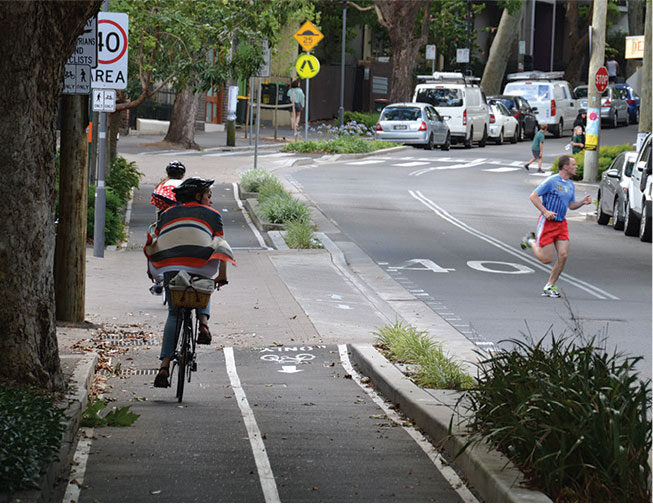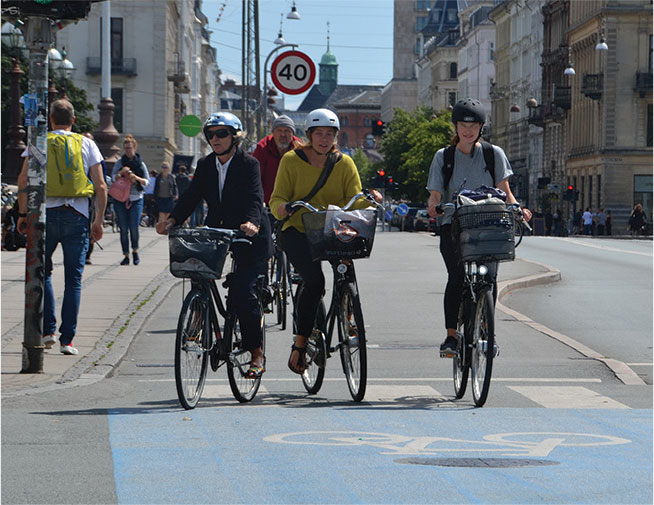-
About Streets
- Introduction
- Defining Streets
-
Shaping Streets
- The Process of Shaping Streets
- Aligning with City and Regional Agendas
- Involving the Right Stakeholders
- Setting a Project Vision
- Communication and Engagement
- Costs and Budgets
- Phasing and Interim Strategies
- Coordination and Project Management
- Implementation and Materials
- Management
- Maintenance
- Institutionalizing Change
- Measuring and Evaluating Streets
-
Street Design Guidance
- Designing Streets for Great Cities
- Designing Streets for Place
-
Designing Streets for People
- Utilities and Infrastructure
- Operational and Management Strategies
- Design Controls
-
Street Transformations
- Streets
-
Intersections
- Intersection Design Strategies
- Intersection Analysis
- Intersection Redesign
- Mini Roundabout
- Small Raised Intersection
- Neighborhood Gateway Intersection
- Intersection of Two-Way and One-Way Streets
- Major Intersection: Reclaiming the Corners
- Major Intersection: Squaring the Circle
- Major Intersection: Cycle Protection
- Complex Intersection: Adding Public Plazas
- Complex Intersection: Improving Traffic Circles
- Complex Intersection: Increasing Permeability
- Resources
Global Street Design Guide
-
About Streets
- Introduction
- Defining Streets
-
Shaping Streets
Back Shaping Streets
- The Process of Shaping Streets
- Aligning with City and Regional Agendas
- Involving the Right Stakeholders
- Setting a Project Vision
- Communication and Engagement
- Costs and Budgets
- Phasing and Interim Strategies
- Coordination and Project Management
- Implementation and Materials
- Management
- Maintenance
- Institutionalizing Change
-
Measuring and Evaluating Streets
Back Measuring and Evaluating Streets
-
Street Design Guidance
-
Designing Streets for Great Cities
Back Designing Streets for Great Cities
-
Designing Streets for Place
Back Designing Streets for Place
-
Designing Streets for People
Back Designing Streets for People
- Comparing Street Users
- A Variety of Street Users
-
Designing for Pedestrians
Back Designing for Pedestrians
- Designing for Cyclists
-
Designing for Transit Riders
Back Designing for Transit Riders
- Overview
- Transit Networks
- Transit Toolbox
-
Transit Facilities
Back Transit Facilities
-
Transit Stops
Back Transit Stops
-
Additional Guidance
Back Additional Guidance
-
Designing for Motorists
Back Designing for Motorists
-
Designing for Freight and Service Operators
Back Designing for Freight and Service Operators
-
Designing for People Doing Business
Back Designing for People Doing Business
-
Utilities and Infrastructure
Back Utilities and Infrastructure
- Utilities
-
Green Infrastructure and Stormwater Management
Back Green Infrastructure and Stormwater Management
-
Lighting and Technology
Back Lighting and Technology
-
Operational and Management Strategies
Back Operational and Management Strategies
- Design Controls
-
Street Transformations
-
Streets
Back Streets
- Street Design Strategies
- Street Typologies
-
Pedestrian-Priority Spaces
Back Pedestrian-Priority Spaces
-
Pedestrian-Only Streets
Back Pedestrian-Only Streets
-
Laneways and Alleys
Back Laneways and Alleys
- Parklets
-
Pedestrian Plazas
Back Pedestrian Plazas
-
Pedestrian-Only Streets
-
Shared Streets
Back Shared Streets
-
Commercial Shared Streets
Back Commercial Shared Streets
-
Residential Shared Streets
Back Residential Shared Streets
-
Commercial Shared Streets
-
Neighborhood Streets
Back Neighborhood Streets
-
Residential Streets
Back Residential Streets
-
Neighborhood Main Streets
Back Neighborhood Main Streets
-
Residential Streets
-
Avenues and Boulevards
Back Avenues and Boulevards
-
Central One-Way Streets
Back Central One-Way Streets
-
Central Two-Way Streets
Back Central Two-Way Streets
- Transit Streets
-
Large Streets with Transit
Back Large Streets with Transit
- Grand Streets
-
Central One-Way Streets
-
Special Conditions
Back Special Conditions
-
Elevated Structure Improvement
Back Elevated Structure Improvement
-
Elevated Structure Removal
Back Elevated Structure Removal
-
Streets to Streams
Back Streets to Streams
-
Temporary Street Closures
Back Temporary Street Closures
-
Post-Industrial Revitalization
Back Post-Industrial Revitalization
-
Waterfront and Parkside Streets
Back Waterfront and Parkside Streets
-
Historic Streets
Back Historic Streets
-
Elevated Structure Improvement
-
Streets in Informal Areas
Back Streets in Informal Areas
-
Intersections
Back Intersections
- Intersection Design Strategies
- Intersection Analysis
- Intersection Redesign
- Mini Roundabout
- Small Raised Intersection
- Neighborhood Gateway Intersection
- Intersection of Two-Way and One-Way Streets
- Major Intersection: Reclaiming the Corners
- Major Intersection: Squaring the Circle
- Major Intersection: Cycle Protection
- Complex Intersection: Adding Public Plazas
- Complex Intersection: Improving Traffic Circles
- Complex Intersection: Increasing Permeability
- Resources
- Guides & Publications
- Global Street Design Guide
- Designing Streets for People
- Designing for Cyclists
- Cycle Networks
Cycle Networks
In order to promote cycling as a viable transportation option, a comprehensive network of cycle facilities must be planned and designed. A hierarchy of routes should be based on the existing urban street network and key destinations. Integrate cycle
networks with transit systems and pedestrian priority areas. The design of cycle networks should consider safety, capacity, and connectivity for all riders. Design for future capacity and mode share goals rather than present-day demands.
Safety
Safety
Cities should design and implement cycle facilities that provide safe routes for cycling for all ages and abilities. Facilities should be well maintained and kept clear of debris and obstacles.
Sightlines
Ensure that facilities provide clear sightlines for the person on a cycle to clearly see pedestrians and motorists as well as parked cars.
Comfort
Comfort and Quality
Provide low-stress facilities for less confident riders. The quality of the facility, the amount of space to ride, and the buffer between moving vehicles will all impact a route’s usability and safety. The smoothness of the surface, the clear drainage of water, and added landscaping will all contribute to a quality ride. Trees can add protection and shade in hot climates.
Signage and Communication
Provide clear wayfinding for cycles and signage for drivers to increase awareness among users. Indicate distances, directions, priorities, and zones shared with other users through ground markings and signage. Map the city’s cycle network and show route types. Tie cycle network developments with media campaigns and public events such as open streets or ride-to-work/school programs and promote cycle facilities. Signage and communication allow cyclists to better navigate the city and increase overall mode share.
Connectivity
Connected and Continuous
Cycle routes should allow cyclists to reach their destinations. While the types of lanes may vary along the way, ensuring that cycle facilities are continuous is critical to promoting cycling as an attractive and sustainable mode of transportation.
Comprehensive
Ensure that the network covers all neighborhoods and offers equitable access to cycle facilities and infrastructure. Destinations such as transit stations, schools, parks, markets, community centers, factories, and office areas should be connected directly when planning cycle networks.
Direct
A cycle network must get riders where they are going in a direct and convenient fashion, avoiding circuitous routes where possible. In cases where steep inclines or hills exist, less direct routes might be preferable if the total path is flatter. Contraflow cycle streets can improve permeability and access for riders when adopted as a citywide approach and supported by increased awareness by motorists.
THE WIGGLE, CYCLE FLAT ROUTE SAN FRANCISCO
UNITED STATES
The Wiggle is the local name given to a portion of San Francisco’s cycle network—a relatively flat route between downtown San Francisco and Golden Gate Park, enabling cyclists to avoid some of San Francisco’s steep hills. The Wiggle inclines, on average, at 3% and does not exceed 6%, connecting various street blocks in a zig-zag pattern. Cyclists can now travel the Wiggle between major eastern and central neighborhoods, and major western neighborhoods on connected cycle facilities.


Cycle Networks: Cities should prioritize cycling as a sustainable mode of transportation by ensuring comprehensive cycle networks are planned and implemented. Offering a range of cycle facilities that provide safe, convenient, and connected routes will help cyclists to reach key destinations without the need for motorized travel. Complement cycle networks with cycle parking spaces, clear wayfinding, cycle share programs, and connections to collective transport infrastructure.




Adapted by Global Street Design Guide published by Island Press.
Next Section —